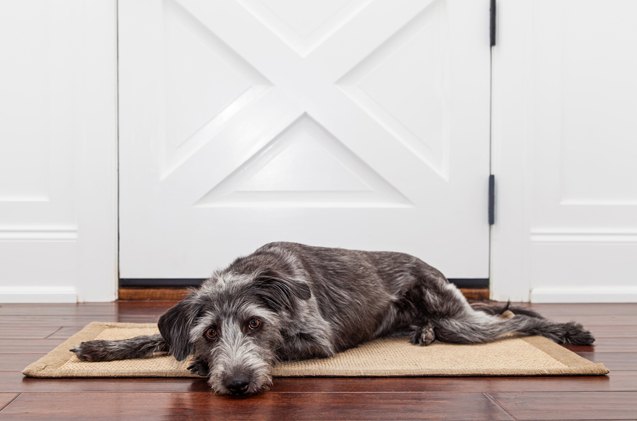How To Spot True Separation Anxiety in Your Dog

Know the Signs
At this point, you might assume your dog has separation anxiety and your life is about to be turned upside down. True separation anxiety can be a difficult issue to deal with, but the good news is that many people who think their dogs have separation anxiety are mistaken. In this case, it’s good to be wrong! What looks like separation anxiety may actually be temporary stress when a dog comes to a new home, a surplus of doggie energy that is not being sufficiently burned, or plain old boredom while home alone.
Related: 8 Tips For Boarding a Dog with Separation Anxiety
Separation anxiety is essentially a panic attack that occurs when a dog is isolated from his human(s). Having a friend stay with the dog, or even getting a second dog, won’t ease his suffering. Another form of separation anxiety is called isolation distress, which bears the same symptoms as full-blown separation anxiety when the dog is left completely alone, but the dog is calm if left with another person or animal. These are some telltale signs that your dog may have separation anxiety or isolation distress:
- constant barking or howling while you are gone,
- panting,
- drooling,
- dilated pupils,
- clawing or biting near the exits (such as doors or windows) as he tries to escape,
- lack of interest in high-value treats,
- self-injury during these escape attempts, and
- peeing or pooping indoors.
On the flip side, these things indicate something other than separation anxiety:
- barking that lasts for several minutes after you leave your home, or barking when the dog hears a noise,
- tearing apart furniture or other items that are unrelated to the exits, and
- peeing or pooping indoors.
It’s no accident that I put “peeing or pooping indoors” in both categories. Though it could indicate separation anxiety, you first have to rule out all other reasons. First, if your dog has had any other accidents in the last six months, especially while you were home, then it may be a housetraining issue. Also consider if you have changed anything in your dog’s routine, including food, supplements, medication, amount of attention, or walk schedule. Even take the weather and the noises outside (such as jarring construction) into account.
However, if your dog is otherwise housetrained and has done his business outside before being left alone, an accident might indicate separation anxiety. This is particularly true if it your dog soils his crate, as most (though not all) dogs prefer not to eliminate where they sleep.
Related: Cannabidiol Soft Chews May Help Dogs With Separation Anxiety
Be a Doggie Detective
Part of the problem with owners misdiagnosing separation anxiety is that they aren’t there to see it, so the information comes from neighbors who may be either downplaying or exaggerating the issue. It’s wise to do a little spying on your dog.
There are numerous home security cameras that allow you to remotely watch your dog while he’s home alone, or you can simply set up a Skype or Facetime call with him. (This will require you starting a video call between your computer and smartphone while you’re home, and then keeping the call on while you leave the house.) While watching your dog, note his activity around the exits, whether he is panting and drooling, and the duration of his barking or crying. If you left some delicious treats for him, has he touched them?
Also consider your dog’s behavior while you’re at home. If your dog simply is bored or has a surplus of energy, he might be destroying furniture, running, and barking while you’re home, too. This can usually be resolved with a combination of increased exercise (or the addition of doggie daycare), loads of treat-dispensing toys to play with while he’s home alone, and consistent positive-reinforcement training to teach him polite behavior. If, on the other hand, your dog is of the “Velcro” variety, following you from room to room, this could indicate separation anxiety.
Not all dogs with separation anxiety fit the traditional mold, so if you think your dog truly has this problem, contact a qualified trainer or behavior specialist. A professional can help you develop a plan that fits your and your dog’s lifestyle.

Kate Naito, CPDT-KA, is a dog trainer at Doggie Academy in Brooklyn, NY, and author of the training book, "BKLN Manners." She draws upon her experience as an educator and dog trainer to apply positive training techniques to a challenging urban environment. Kate is a rescue advocate drawn to special-needs dogs and currently has two Chihuahua mixes, Batman and Beans.
More by Kate Naito























